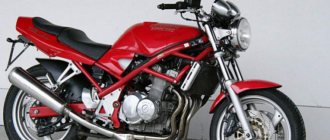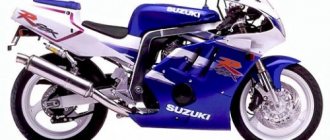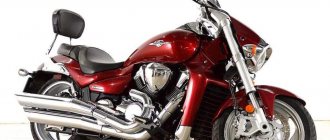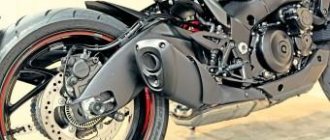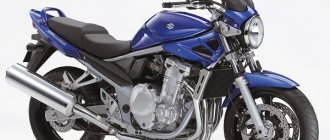Description
The Suzuki GSX-R 250 sports motorcycle model was produced from 1987 to 1991. The motorcycle had an inline 4-cylinder engine, liquid cooling and a steel frame. At that time, it was a high-tech motorcycle with outstanding dynamic characteristics - in tests it was possible to squeeze out more than 200 km/h, which was a fantastic result for 250 cc models.
Meanwhile, Suzuki, along with other major Japanese motorcycle manufacturers, quickly abandoned the concept of small-capacity inline-fours due to their very weak engine life. And if such a problem is not so critical for track driving, then for everyday driving around the city it was fatal.
The Suzuki GSX-R250 sports motorcycle is a rather rare representative of small-capacity racing motorcycles. Don’t be fooled by its 250cc volume - this is truly a sportbike, and one that can outshine most of its modern classmates in terms of cubic capacity, despite the fact that they are separated by a quarter of a century. For its time, this motorcycle was very modern and technologically advanced, however, it was produced for only four years, from 1987 to 1991. The main problem of the model was the low engine life, due to the high degree of engine boost.
The power unit on the Suzuki GSX-R250 was a 250 cc liquid-cooled inline-four. Power 45 forces, torque - 25 Nm. It would seem that many modern small-capacity sportbikes like the Kawasaki Ninja 250 have similar parameters, but the GSX-R250 reached a maximum speed of up to 200 kilometers per hour, which is practically a record for a motorcycle with an engine of this size. Its engine loves high revs, producing maximum power at around 15,000 rpm, and the 6-speed transmission features a long top gear. Acceleration from 0 to 100 km/h takes about 8 seconds.
This motorcycle can be called quite small and light, its dry weight is about 135 kg. There was also a racing version of the Suzuki GSX-R250 SP, which weighed a couple of kilograms less and had a 13-liter gas tank versus 16-liter on the regular version. By the way, the small-capacity car does not have a moderate appetite, easily consuming 6-7 liters per hundred, depending on the driving mode. However, despite the fact that the GSX-R250 was sold for use on public roads, its original purpose was precisely the racing track, where consumption is not critical, as is the modest engine life.
The Suzuki GSX-R250 is very easy to drive. Compact dimensions, low weight and narrow tires (100mm front and 130mm rear) make it very nimble and maneuverable; it can easily take a new sharp turn, barely leaving the previous one. True, its suspension cannot be called modern now, but for its time it was more than relevant. All versions of the motorcycle were equipped with a telescopic fork and a progressive monoshock absorber at the rear. Due to the aforementioned modest size of the bike, it is comfortable for people of average height to sit on it. The seating position involves a forward tilt - the clip-ons are located low, and the driver's footpegs are set slightly back, easily inviting the motorcyclist to lie down on the gas tank and hide behind the fairing, which, by the way, copes with the pressure of the wind at any speed up to maximum. The brakes on the Suzuki GSX-R250 are excellent - two wide 300 mm discs with 2-piston calipers at the front, plus one more modest disc at the rear.
Nowadays, it is very difficult to find a “live” copy of the Suzuki GSX-R250 for sale. The motorcycle was not produced for long, only four years, besides, the last copies rolled off the assembly line twenty-five years ago, and the reason for its discontinuation was the low engine life.
Similar articles:
- Review of Suzuki GSF 250 Bandit
- Yamaha YZF 750 review
- Yamaha FZR 1000 Review
- Review of Suzuki VZ 400 Desperado
- Honda VTR 1000 Firestorm review
- Yamaha FZX 250 Zeal review
LiveJournal
Specifications
| Model: | Suzuki GSX-R 250 |
| Type: | Sport |
| Year of issue: | 1987 - 1994 |
| Frame: | Steel |
| Engine's type: | 4 - cylinder, 4 - stroke |
| Working volume: | 248 cc cm. |
| Bore and stroke: | 49 mm x 33 mm |
| Compression ratio: | 12.5:1 |
| Cooling: | Liquid |
| Number of valves per cylinder: | 4,DOHC |
| Fuel supply system: | Carburetor Mikuni BSW 27 |
| Ignition type: | Electronic |
| Maximum power: | 45 hp at 15000 rpm. |
| Maximum torque: | 25 Nm at 10500 rpm. |
| Transmission: | 6-speed |
| Type of drive: | Chain |
| Front tire size: | 100/80-17 52H |
| Rear tire size: | 130/70-17 62H |
| Front brake: | Twin 300mm discs, 2-piston caliper |
| Rear brake: | One 250 mm disc, 1 piston caliper |
| Front suspension: | 41 mm telescopic fork |
| Rear suspension: | Monoshock with progression |
| Wheelbase: | 1370 mm |
| Seat height: | 730 mm |
| Acceleration to 100 km/h: | ~ 8 sec. |
| Maximum speed: | 180 km/h |
| Gas tank capacity: | 16 l. |
| Dry weight: | 138 kg. |
Review of the Suzuki GSX-R 250 motorcycle
This bike is not worth taking. Either 400 and above, or 250, but not ForInline obviously. Take one or two cylinder devices of this volume, even if they are WeTwins but not fours, and even those that are machined for high speeds. You’ll spit in the city and on the highway, it’s not worth it. Why else do you need a motorcycle?
A very light (136 kg) full-fledged sports bike, despite its 250 cm cubic capacity, it has a full-fledged, very angry 4-cylinder 16 valve engine. Unlike many 400s, the engine does not have noticeable dips at low speeds, but, of course, there is pick-up after 14,000 revolutions.
The engine produces peak power at 14,500, and spins at its maximum up to 18,500 (before the limiter)! The tachometer is marked up to 20,000, the red zone is 17,000. The entire family of 250 engines has a power of 45 hp. (Japanese). In terms of dynamics, the bike does many 400s, and the handling is also excellent. On the highway it easily gains 180, but its element is the city.
If you are going to ride in the city every day, then this motorcycle is definitely not for you. Although I find it difficult to even say what it is for. Driving on the highway is a bit difficult. Forget about overtaking, and if you decide, then drive the engine into the red zone and make the maneuver as quickly as possible, there is no reserve here and cannot be. Wind protection is not so great. It’s understandable - the dimensions and design are for small Japanese people. I installed a Sigma bike computer and was able to measure the speed on the highway - it turned out to be 160 km/h. He refused to go faster. After 110 it starts to hit your head. If you bend down, of course there are no problems. But how long can you drive like this? In short, the motorcycle is in no way suitable for the track either. Perhaps the track is his element. Again, within its class. Perhaps. Doubtful. It turns out to be a meaningless motorcycle. No matter what, there were enough brakes here. They were quite impressive. There are two discs in front, as befits a true athlete. Information content is not at the worst level. It was possible to make stoppie. The box works fine. There are almost no false neutrals or other fluff here.
However, I didn’t experience any technical problems with it. I changed the oil, filters, spark plugs, lubricated the chain, synchronized the carbs... There were problems with the battery charge. The problem was resolved without any problems.
So the season was coming to an end and so was the time to own this miracle.
At the very end, of course, I fell off it, as usually happens just before closing - the front brakes went sour. But this is a completely different story... The motorcycle is still alive, although it has changed 3 more owners after me, I never lose sight of it.
The only thing that is there and that cannot be taken away is the pontoon appearance by the standards of its time, the ease of maneuvering in the city due to its low weight and dimensions, and... here it is... THE CONCEPT OF A SPORT BIKE. But not more. Just a concept. Although, this pleases and warms the soul of the owner, allowing him not to think so much about the shortcomings of the device.
It's better to gain experience on something else. Fortunately, today there is a huge selection of completely varied equipment.
Driving performance
The maximum speed indicated in the documentation for the motorcycle was 160 km/h . But the owners say that when the mark is reached, there is a reserve of power for another 20–40 km .
Users note crazy acceleration dynamics, but if you look at the specifications - from 0 to 100 in 8.5 seconds .
Fuel consumption
The consumption is quite high - from 4 liters for off-road use, but considering that the motorcycle is designed only for circuit competitions - it can be called normal. Having a tank of 8 liters , the bike can travel almost 200 km on one fill.
If you consider that this is a sports equipment, and according to traffic rules it should not appear on public roads, then the indicator is more than good .
Sixth place: Suzuki RM-Z250 2021 motocross motorcycle
Suzuki RM-Z250 2020
Place, according to the riders: 6-6-6-6-6-6
Last year, Suzuki's RM-Z250 motocross bike received the most updates in years, and the 2019 RM-Z250 was much better than previous yellow 250s. The engine had decent power in the mid to top end of the rev range and the bike was, as always, excellent in corners. Unfortunately, fans of the Suzuki brand had to spend a lot of time finding suitable springs for the suspension and replacing them.
Perhaps in an attempt to avoid a problem that plagues the larger RM-Z450 - where the shock is significantly stiffer than the front forks - Suzuki engineers installed very stiff front fork springs on the RM-Z250 motocross. The result was a fork that was too stiff for all but the fastest or heaviest riders.
For 2021, the Suzuki RM-Z250 does not receive any changes except for a minor graphics change. This is strange - all the specialized media criticized the suspension settings of the Suzuki RM-Z250.
Apart from the unrealistic suspension settings, the Suzuki RM-Z250 is a decent motocross bike with a good engine and excellent handling characteristics. The character of the engine is not the most convenient - the Suzuki's power is concentrated in the middle and upper rev range. The RM-Z250's powerplant can deliver strong results, as evidenced by some riders' strong starts in competition last summer.
Advantages of Suzuki RM-Z250 2020
- Good mid-range power
- Good clutch and transmission performance
- Great looks
- Renthal Fatbars
- Very good in corners if the suspension is set up correctly
Disadvantages of Suzuki RM-Z250 2020
- Kickstarter
- Replacing ECU cards takes time
- Lack of low-end torque
- Unrealistically stiff suspension
- Very rigid chassis
Strengths of the Suzuki RM-Z250, according to riders
The Suzuki RM-Z250 corners exceptionally well, despite being hampered by an overly stiff fork. The Suzuki engine has decent power throughout the entire rev range.
The engine of the motorcycle has good power in the lower and mid range, but is weak in the upper range. The bike's strengths are cornering and fast straights, but that's about it.
Suzuki has always cornered well, and the 2021 RM-Z250 motocross is no exception, turning corners very easily.
I love the look of the Suzuki RM-Z250.
If you're in the right gear, the Suzuki RM-Z250 handles corners very well.
It's a fun bike and handles well. I could put it in the corner the way I wanted. I like the character of the engine, but I would like more horsepower.
Weaknesses of the Suzuki RM-Z250, according to riders
It creates a feeling of uncertainty on a fast straight and when entering corners. The chassis of the Suzuki RM-Z250 is rigid and uncomfortable.
The motorcycle is unpredictable and finicky. The fork is very stiff on landing and when braking.
The suspension is too stiff for my weight, especially the fork. And I don't like Kickstarter.
The Suzuki RM-Z250 fork appears to be tuned for a 100kg rider. Adjustments don't help much, this bike needs serious work on the suspension.
I am tall and felt uncomfortable on the Suzuki. When I needed power, it simply wasn't there.
If there were no other bikes in the test, I would say that the Suzuki RM-Z250 motocross bike is quite fast, but it is not. Compared to other motorcycles, it lacks power.
Suzuki GSX 250F Across
Brief review of Suzuki GSX 250F Across
Suzuki GSX 250F Across is a rather rare representative of the class of small-capacity sports-touring motorcycles designed for novice motorcyclists. It is distinguished from sportbikes of similar engine displacement by a more comfortable fit, softer and energy-intensive suspensions that are not intended for aggressive driving on the track, and a smoother power curve, without pronounced dips and pick-ups. The motorcycle is well suited for training beginners who plan to purchase a more powerful sport-tourer in the future.
The GSX 250F Across saw minor changes throughout its production. The only restyling was carried out in 1990, when the front brake disc was moved to the other side, and a different taillight was also installed. Since 1993, engine power has been reduced to 40 hp. due to new requirements of Japanese legislation, according to which the power of 250 cc models should not exceed this mark. The motorcycle was produced in this form until its discontinuation, remaining virtually the only competitor to another small-capacity sports tourer - the Kawasaki ZZ-R250.
Technical characteristics of Suzuki GSX 250F Across
- Years of production: 1990-1998
- Class: sport-tourist
- Frame: steel
- Engine: 4-stroke, 4-cylinder, in-line
- Engine capacity, cubic meters see: 248
- Cooling: liquid
- Valves per cylinder: 4
- Fuel supply: 2 carburetors
- Power: 45 hp at 14500 rpm (since 1993 - 40 hp)
- Torque: 25.5 Nm at 10500 rpm
- Maximum speed, km/h: 180
- Acceleration from 0 to 100 km/h: ~6.5 seconds
- Transmission: 6-speed
- Wheel drive: chain
- Front tire: 110/70-17
- Rear tire: 140/70-17
- Front brakes: 1 disc 300 mm, 2-piston caliper
- Rear brakes: 1 disc 240 mm, 1-piston caliper
- Front suspension: telescopic fork
- Rear suspension: progressive monoshock
- Gas tank volume, liters: 12
- Fuel consumption at 110 km/h, liters: ~5.1
- Dry weight, kg: 163
Pros and benefits of the Suzuki GSX 250F Across
- Advanced wind protection
- Comfortable straight fit
- Energy-intensive pendants
- Affordable price
- Sufficiently spacious luggage compartment under the false tank
- Light weight
Pros and cons of the Suzuki GSX 250F Across
- Small gas tank, especially by the standards of touring motorcycles
- Weak traction at the bottom
- Low resource of a forced small-capacity engine
- High fuel consumption
- Tight grip
